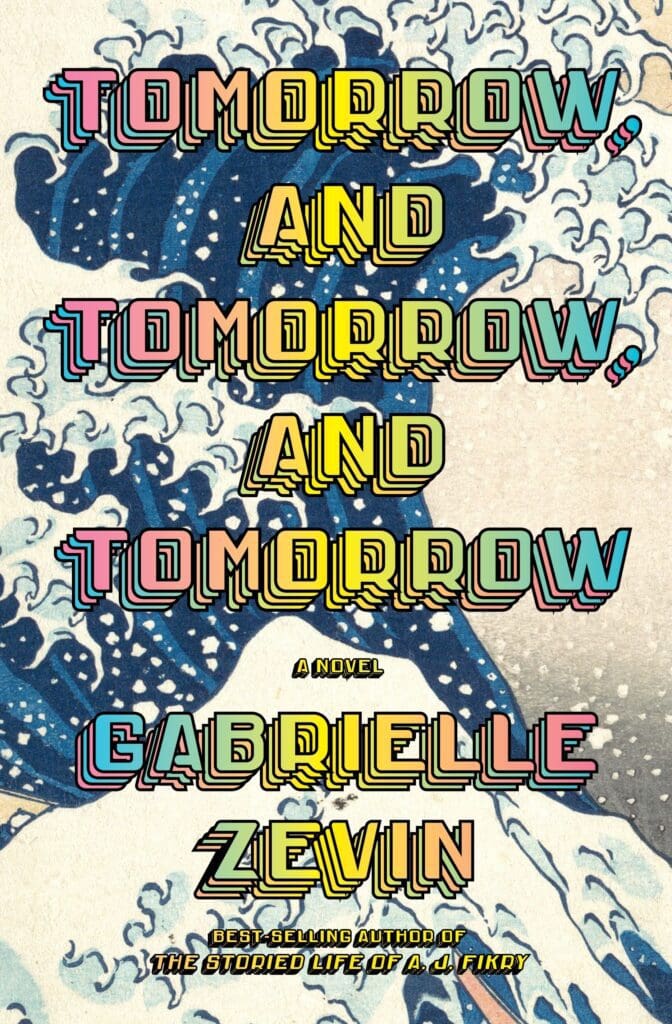If ever there were ever a novel that replicates the addictive, multi-level quality of video games, it would be Gabrielle Zevin’s Tomorrow, and Tomorrow, and Tomorrow (416 pages; Knopf),an endearing and loving portrait of three friends who start their own video game company.
When they’re eleven, Sam and Sadie meet at the hospital. Sadie’s sister, Alice, is recovering from leukemia, and Sam is recovering from a terrible car accident that practically destroys one of his feet, an injury that haunts him throughout his life. As they wait around, they begin to play video games together, developing the bridge of play that will bind them for the rest of their lives.
In this way, Sam and Sadie fall in love at a young age, though their love is platonic. This love flourishes despite their disparate backgrounds: Sadie grew up in Beverly Hills in an affluent Jewish family, while Sam was raised in Koreatown by his Korean grandparents after the death of his mother in the very accident that demolished Sam’s foot.
They had the rare kind of friendship that allowed for a great deal of privacy within it. One of the reasons they had become such good friends originally was because she had not insisted he tell his sad stories to satisfy her own curiosity.
Eventually, the two experience a falling out and don’t speak again until they’re twenty years-old and gifted in their respective fields at college—Sadie in computer science, Sam in math. Sadie has been trying her hand at game design and, after running into Sam in the subway, gives him a copy of the game that has won her the romantic and intellectual attention of her provocative games professor.
After playing Sadie’s first creation, Solution, an edgy game about complicity and the Holocaust that disturbs one of Sadie’s classmates, Sam and his best friend, Marx, propose a deal to Sadie: Sam wants to create a video game with her, with Marx as producer. She agrees, and Sadie and Sam create Ichigo, their first game. After initial success, the trio moves to Venice Beach to buy an office and start a company called Unfair Games.
Tomorrow, and Tomorrow, and Tomorrow spans thirty years of friendships, the trials and tribulations of the trio—issues surrounding gender, race, health—as their studio takes off. The reader’s sympathy for each character grows and shifts as Zevin moves omnisciently between the two childhood friends: we empathize with Sadie’s anger at Sam when he shows up to work late and leaves early, and then we empathize with Sam when we find out that he’s in extreme pain after his foot surgery and is too scared to be away from home. We see how the boundaries of their relationship, which had been before rendered so loving and deep, with its emphasis on mutual play, also keeps them from expressing themselves clearly to each other.
Then there’s Marx, perhaps the most likable character in the novel, whose dedication to Sam and Sadie knows no bounds:
Why did Marx do this for this strange boy, who most people found vaguely unpleasant? He liked Sam. He had spent his childhood among rich and supposedly interesting people, and he knew that truly unusual minds were rare… So, he protected Sam, and he made the world a little easier for Sam, and it cost him next to nothing to do so. Marx… found it natural to care for those around him.
Late in the novel, Sam is angry at Max and calls him an “NPC”—a Non-Player Character—meaning a computer-generated figure that solely serves as background texture for a game; in recent years, NPC has become an online insult meant to mock a person’s perceived lack of interiority and critical thought. In some ways, Marx is a background character: he supports the two main characters while they go about their business, designing games and being geniuses. And yet he’s also a critical character in that nothing could function without his kindness and ability to see the best in people and guide their company to good things.
Part of the effectiveness of Tomorrow, and Tomorrow, and Tomorrow is Zevin’s not-too-technical portrayal of the games that Sam and Sadie create. In video games, there are always narratives, in-depth character constructions, and, of course, aesthetic considerations, and so there is a meta-element of a story within the story as each game is developed. In reading, it feels as if one is actually designing and playing the games with Sam and Sadie and Marx, and this creates an intimacy that mirrors the one shared by the central characters. Each chapter is titled for a section of life—“Sick Kids,” “Influences,” “Marriages”—but they are more like game levels than chapters, stories within stories to be explored and passed through.
Zevin’s novel is evocative in its descriptions of video games; even for those who do not play them, she conveys the medium as a thing of beauty and artistry. And she asks, how does “play” inform relationships? How does work sweep away play? And how can we achieve genuine intimacy in the midst of play? In this love story, Zevin underscores how Sam and Sadie are not playing to win but, rather, to experience.

